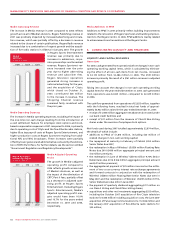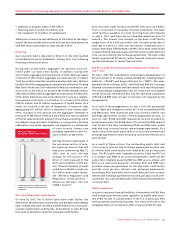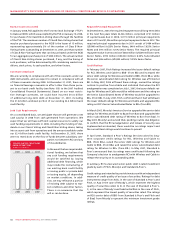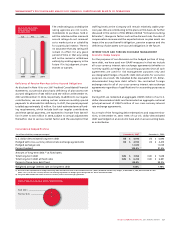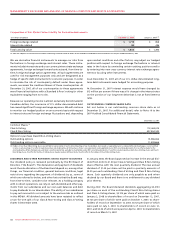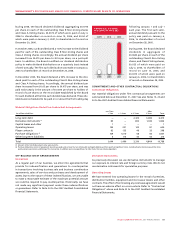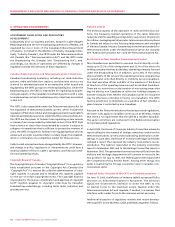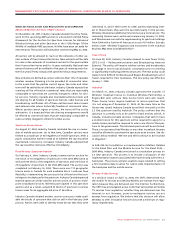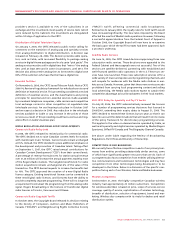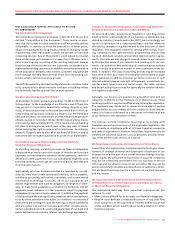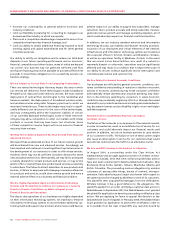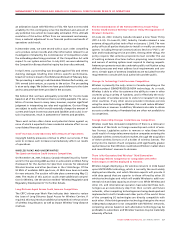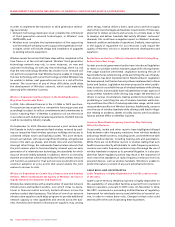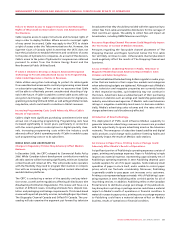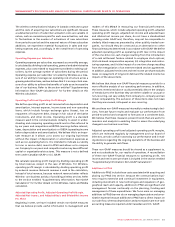Rogers 2007 Annual Report Download - page 56
Download and view the complete annual report
Please find page 56 of the 2007 Rogers annual report below. You can navigate through the pages in the report by either clicking on the pages listed below, or by using the keyword search tool below to find specific information within the annual report.
52 ROGERS COMMUNICATIONS INC. 2007 ANNUAL REPORT
MANAGEMENT’S DISCUSSION AND ANALYSIS OF FINANCIAL CONDITION AND RESULTS OF OPERATIONS
CABLE REGUL ATION AND REGULATORY DEVELOPMENTS
Part II Fees
The CRTC collects two different types of fees from broadcast licen-
cees. These are known as Part I and Part II fees. In 2003 and 2004,
lawsuits were commenced in the Federal Court, alleging that the
Part II licence fees are taxes rather than fees and that the regula-
tions authorizing them are unlawful. On December 14, 2006, the
Federal Court ruled that the CRTC did not have the jurisdiction to
charge Part II fees. The Court ruled that licencees were not entitled
to a refund of past fees paid. Both the Crown and the applicants
have appealed this case to the Federal Court of Appeal. The appli-
cants are seeking an order requiring a refund of past fees paid. The
Crown is seeking to reverse the finding that Part II fees are unlaw-
ful. On October 15, 2007, the CRTC sent a letter to all broadcast
licencees, including Cable and Rogers Broadcasting, stating that
the CRTC would not collect Part II licence fees due on November 30,
2007 and subsequent years unless the Federal Court of Appeal or
the Supreme Court of Canada (should the case be appealed to that
level) reverses the Federal Court’s decision. The Federal Court of
Appeal heard the appeal on December 4 and 5, 2007, but has not
yet rendered a decision.
Diversity of Ownership
In light of recent acquisition announcements in the Canadian
broadcasting industry, the CRTC launched a public proceeding
to review its approach to ownership consolidation and the avail-
ability of a diversity of voices in the broadcasting system. The
CRTC examined issues such as common ownership; concentration
of ownership; horizontal and vertical integration; the benefits
policy; licence trafficking; as well as the CRTC’s relationship with
the Competition Bureau. The decision was released on January 15,
2008. The decision announced that companies would not be able
to own local newspapers, television stations and radio stations in
a given local market. Television broadcasters cannot own more
than 45% of the market (including both over-the-air and specialty)
measured by total hours tuned. Broadcast distribution undertak-
ings cannot control all of the distribution network in the market.
Management does not believe that these restrictions will impact
our current plans.
Review of Broadcasting Regulations
On May 10, 2007, the Chair of the CRTC announced that the CRTC
had commissioned a report to look at all Canadian broadcasting
regulations. The report will look at each regulation or policy and
ask what its original purpose was, whether it is still relevant and
effective and whether it should be retained, improved, streamlined
or eliminated. A hearing on this matter is scheduled for April 7,
2008. On July 5, 2007, the CRTC issued Broadcasting Notice of Public
Hearing CRTC 2007-10; Review of the regulatory frameworks for
broadcasting distribution undertakings and discretionary program-
ming services. This proceeding is a comprehensive review of the
regulations affecting cable operators and pay and specialty ser-
vices. The CRTC has made a number of proposals designed to move
away from detailed regulation and rely more on market forces.
On September 12, 2007, the CRTC released the Dunbar/Leblanc
report. The report recommended changes to the rules in a number
of areas including simultaneous substitution, genre protection,
access and advertising. The reports’ recommendations, if adopted,
could have a material impact on our Broadcasting and Cable opera-
tions. The reports’ recommendations will be examined in the April
hearing.
Fee-for-Carriage and Distant Signal Fees
On May 17, 2007, the CRTC released Determination regarding
certain aspects of the regulatory framework for over-the-air tele-
vision; Broadcasting Public Notice CRTC 2007-53. In that decision,
the Commission determined that it would not adopt a fee for
the carriage of over-the-air television stations by Broadcasting
Distribution Undertakings. On November 6, 2007, the Commission
determined that it would broaden the scope of Review of the regu-
latory frameworks for broadcasting distribution undertakings and
discretionary programming services; Broadcasting Notice of Public
Hearing CRTC 2007-10 by including a re-examination of the fee-for-
carriage issue. On November 30, 2007, the Commission clarified that
it considered issues related to distant signals to be within the scope
of this proceeding. We expect that some parties to the proceeding
will make proposals for increases in the fees that we pay for these
distant signals.
Canadian Television Fund
On February 20, 2007, the CRTC set up a task force to investigate
issues related to the funding of Canadian programming and the
governance of the Canadian Television Fund. It consulted broadly
within the industry and issued a Report with recommendations on
June 29, 2007. Among other things, the Report recommended that
the Broadcasting Distribution Regulations be amended so that funds
contributed by broadcast distribution undertakings be allocated to
a more flexible and market-oriented private sector funding stream,
and that a $25 million New Media Fund be established. The CRTC
then asked for comments on the Task Force’s recommendations
and received 184 comments on July 27, 2007, from all sectors of the
broadcasting industry. On November 5, 2007, the CRTC announced
it would hold a public hearing on a variety of issues raised in the
Report, primarily related to the establishment of the private sector
funding stream and the criteria that must be met in order to access
the funding. However, it also announced it would examine at the
hearing whether BDUs and VOD services should contribute more to
the fund (BDUs already contribute 5% of their gross broadcasting
revenues while VOD services contribute 5% of gross revenues
(defined as 50% of the retail price for a VOD title)). We expect that
a number of parties to the proceeding will support increases to the
contributions currently made by BDUs and VOD services.
Local Telephone Forbearance
On April 4, 2007, the Federal Cabinet overturned the CRTC’s 2006
Local Forbearance Decision. Effective April 4, 2007, the CRTC rules
on winback (which prohibited the incumbent phone companies
from contacting customers for three months after they chose an
alternate telephone provider) and promotions (which imposed
competitive safeguards for temporary pricing changes) were
removed. In addition, the incumbent phone companies are able to
apply for deregulation by simply showing that they compete with a
wireline facilities-based provider and a wireless facilities provider in
a telephone exchange. As long as the competitive wireline facilities




